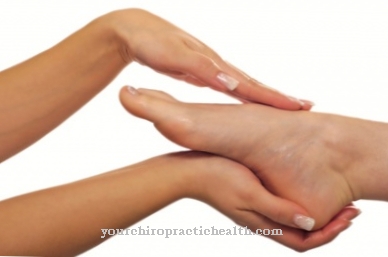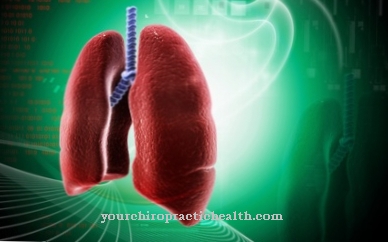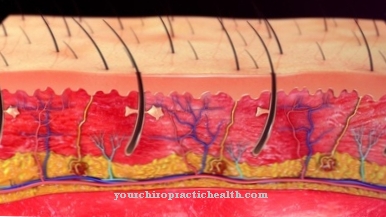Bite refers to the strong closing of the teeth in order to chop up food or to defend oneself, as in the animal kingdom. This can lead to serious injuries that can be life-threatening. Bite wounds can also become infected quickly and require appropriate treatment to prevent infection.
What is the bite?

In common parlance, the word “bite” is also used as a synonym for chopping up food. Mostly it is used to describe an attack and an injury by the teeth of a person or animal. In the animal kingdom in particular, biting is also considered a threatening gesture to drive away potential threats or competitors.
Bite wounds are so-called mechanical wounds that are caused by the action of teeth on the skin and flesh. They resemble lacerated wounds or stab wounds and vary in severity depending on the attacker's teeth.
Endogenous toxins can also get into the victim's organism through biting. This is the case, for example, with snakes, which can kill with a targeted bite. But even without poison, wounds caused by bites can be dangerous. The contact of the teeth and the oral mucosa with the open wound quickly leads to infections. Disinfecting even small bite wounds is therefore very important.
Biting means an interaction between the chewing muscles and the muscles in the tongue, cheeks and lips. The teeth are also involved to varying degrees, because they crush, chop and grind the food in the oral cavity. If there are diseases that damage the jawbones, muscles or teeth or impair their function, biting and chewing are made significantly more difficult. In the worst case, there may be a cessation of food intake.
Function & task
Biting fulfills important functions. With the help of the teeth, food can be divided into smaller portions and then chopped up. In the early stages of human history, this was the only way to ingest food as tools to chop it up were still lacking. Those who couldn't bite or bite off had to starve. Today people can use knives, forks or even devices for pureeing and no longer have to rely so heavily on the strength of their teeth. In addition, today we can have artificial teeth made if necessary.
The biting process begins with the food or object to be bitten being positioned between the teeth with the help of the tongue. Crushing takes place with the help of repeated opening and closing of the jaw. When opening, the muscles of the floor of the mouth in particular come into action, when closing, the temporalis muscles. The back rows of teeth such as the molars and wisdom teeth are used to grind food. Biting off and crushing, on the other hand, is done by the incisors. If there are large gaps in their teeth, the person will have to use more force to bite and chew than a person with full set of teeth.
In the context of an argument, humans, unlike animals, only bite in emergency situations if they don't know how to defend themselves otherwise. Such behavior no longer has a place in human interaction, and biting is only restricted to eating. The jaw muscles play a special role. This is where the strongest muscles in the human body are located. The human bite force is around 80 kg (in comparison, a lion has a bite force of 560 kg) or 30 Newtons. In theory, even higher values would be possible; however, biting the upper and lower jaw too hard causes toothache and muscle tension, which prevents a greater biting force from being applied.
In the animal kingdom, biting one another is still part of everyday life. It is used to defend yourself, fend off competitors or hunt prey. People, on the other hand, only bite in emergency situations if they don't know how to defend themselves otherwise. It is common for young children under the age of two to bite each other and their parents as well. This is considered normal behavior in this age group because they are just beginning to discover their bodies and cannot yet foresee that biting can also cause pain. From kindergarten age onwards, biting other people should be a thing of the past. Such behavior no longer has a place in human interaction, and biting is only restricted to eating.
You can find your medication here
➔ Medication for toothacheIllnesses & ailments
The biting process itself can also be impaired by illnesses or injuries. In this context, damage to the teeth occurs particularly frequently, making it difficult or impossible to bite. Dental treatment is required to restore the broken teeth.
If this does not succeed due to excessive damage, an appropriate denture can be made and inserted. This usually completely restores the bite and chew function. If the muscles in the jaw area are diseased or injured, the important movements when biting can be made difficult or even completely stopped. This is the case, for example, when the muscles of the floor of the mouth are paralyzed.
If the jaw muscles tighten in a painful way, irritated facial nerves can be responsible. Nocturnal unconscious teeth grinding can also cause noticeable hardening of the masticatory muscles, as well as abrasion or even breaking off of the teeth. Earache and headache are also accompanying symptoms of the crunching, which is often caused by stress.
When humans or animals bite, they injure the skin and tissue of their counterpart with their teeth. This leads to a bite wound, which can turn out very differently depending on the size and tooth profile of the attacker. Most of the bites that are treated in doctor's offices and hospitals come from dogs and cats. Dog bites are often quite large and often show bruises and torn wound edges. Cat bites are much smaller and more punctiform, but they are deeper than comparable dog bites. This makes cat bites potentially more dangerous due to the nature of the teeth, as they allow more germs to penetrate the wound.
Most dangerous, however, are human bites. Although these are not very common, they carry a high risk of infection. Up to a hundred billion different germs and bacteria can be found in just one milliliter of human saliva. In addition, biting can transmit serious diseases such as hepatitis or HIV.
If an injury occurs from a bite, the wound should always be disinfected. In the case of very small bite wounds, this can be done at home and, with appropriate observation, medical treatment is not always necessary in these cases. Larger injuries, on the other hand, should always be presented to a doctor. It may be necessary that the wound is sutured after cleaning and then bandaged in a sterile manner. A sterile bandage is also advisable for self-treated bites. This can prevent additional germs from penetrating the injury and causing infections. After a period of six hours, large bite wounds are no longer sewn for this reason, as the risk of infection would be too great.
After cleaning, a wound drainage can also be placed, which removes wound water. A so-called interactive wound pad can also absorb wound secretions and also prevents them from drying out. This can speed up the healing process.
In addition to a high risk of infection, animal bites also harbor the risk of contracting rabies or the development of tetanus (tetanus). There is now a vaccination against rabies, which can also be carried out after the bite. A tetanus vaccination should take place approximately every ten years in order to have active vaccination protection at all times.
























.jpg)



